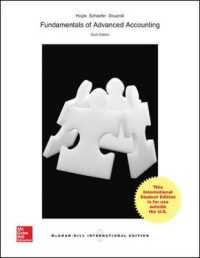- ホーム
- > 洋書
- > 英文書
- > Nature / Ecology
Full Description
Presenting new approaches to studying food webs, this book uses practical management and policy examples to demonstrate the theory behind ecosystem management decisions and the broader issue of sustainability. All the information that readers need to use food web analyses as a tool for understanding and quantifying transition processes is provided. Advancing the idea of food webs as complex adaptive systems, readers are challenged to rethink how changes in environmental conditions affect these systems. Beginning with the current state of thinking about community organisation, complexity and stability, the book moves on to focus on the traits of organisms, the adaptive nature of communities and their impacts on ecosystem function. The final section of the book addresses the applications to management and sustainability. By helping to understand the complexities of multispecies networks, this book provides insights into the evolution of organisms and the fate of ecosystems in a changing world.
Contents
Preface; Part I. Food Webs: Complexity and Stability: 1. Food webs versus interaction networks: principles, pitfalls and perspectives Carsten F. Dormann and Nico Blüthgen; 2. What kind of interaction-type diversity matters for community stability? Michio Kondoh and Akihiko Mougi; 3. Symmetry, asymmetry and beyond: the crucial role of interaction strength in the complexity-stability debate Anje-Margriet Neutel and Michael A. S. Thorne; 4. Ecologically effective population sizes and functional extinction of species in ecosystems Bo Ebenman, Torbjörn Säterberg and Stefan Sellman; 5. Merging antagonistic and mutualistic bipartite webs: a first step to integrate interaction diversity into network approaches Elisa Thébault, Alix M. C. Sauve and Colin Fontaine; 6. Toward multiplex ecological networks: accounting for multiple interaction types to understand community structure and dynamics Sonia Kéfi, Elisa Thébault, Anna Eklöf, Miguel Lurgi, Andrew J. Davis, Michio Kondoh and Jennifer Adams Krumins; 7. Unpacking resilience in food webs: an emergent property or a sum of the parts? R. M. Thompson and Richard Williams; Part II. Food Webs: From Traits to Ecosystem Functioning: 8. Integrating food-web and trait-based ecology to investigate biomass-trait-feedbacks Ursula Gaedke and Toni Klauschies; 9. Including the life cycle in food webs Karin A. Nilsson, Amanda L. Caskenette, Christian Guill, Martin Hartvig and Floor H. Soudijn; 10. Importance of trait-related flexibility for food web dynamics and the maintenance of biodiversity Ursula Gaedke, Beatrix E. Beisner, Amrei Binzer, Amy Downing, Christian Guill, Toni Klauschies, Jan J. Kuiper, Floor H. Soudijn and Wolf M. Mooij; 11. Ecological succession investigated through food web flow networks Antonio Bodini, Cristina Bondavalli and Giampaolo Rossetti; 12. Statistical approaches for inferring and predicting food-web architecture Rudolf P. Rohr, Russell E. Naisbit, Christian Mazza and Louis-Félix Bersier; 13. Global metawebs of spider predation highlight consequences of land-use change for terrestrial predator-prey networks Klaus Birkhofer, Eva Diehl, Volkmar Wolters and Henrik G. Smith; 14. Ecological networks in managed ecosystems: connecting structure to services Christian Mulder, Valentina Sechi, Guy Woodward and Davib Andrew Bohan; 15. Trait-based and process-oriented modeling in ecological network dynamics Marco Scotti, Martin Hartvig, Kirk O. Winemiller, Yuanheng Li, Frank Jauker, Ferenc Jordán and Carsten Dormann; 16. Empirical methods of identifying and quantifying trophic interactions for constructing 3 soil food web models Amber Heijboer, Liliane Ruess, Michael Traugott, Alexandre Jousset and Peter de Ruiter; Part III. Food Webs and Environmental Sustainability: 17. Integrating species interaction networks and biogeography José M. Montoya and Núria Galiana; 18. Food web dynamics when divergent life history strategies respond to environmental variation differently: a fisheries ecology perspective Kirk O. Winemiller; 19. Rare but important: perturbations to uncommon species can have large impact on the structure of ecological communities Tomas Jonsson, Sofia Berg, Torbjörn Säterberg, Céline Hauzy and Bo Ebenman; 20. Food web simulations: stochastic variability and systems-based conservation Ferenc Jordán, Marco Scotti, and Catherine M. Yule; 21. An individual-based simulation model to link population, community and metacommunity dynamics Marco Scotti and Ferenc Jordán; 22. Structural instability of food webs and food-web models and its implications for management Axel G. Rossberg, Amanda Caskenette and Louis-Felix Bersier; 23. Linking ecology and epidemiology: the case of infected resource Sanja Selakovic, Peter de Ruiter and Hans Heesterbeek.








